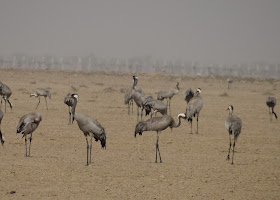 |
| Common Crane |
Our six-week sojourn to India and Sri Lanka began with a week in Gujarat province in north-west India. Here, the primary target was the Hypocolius, found easily and reported
in the following post, Many other excellent birds are to be found in this vast expanse of arid grassland, ephemeral wetlands and thornbush scrub on the Pakistan border. Our trip was organised by Jugal Tiwari of the Centre of Deserts and Ocean (CEDO). Jugal runs an excellent homestay, our base for the trip.
 |
| Hypocolius |
 |
| Rosy Starling |
Our first morning saw us near the village of Fulay in an area of shrubby woodland. Apart from the Hypocolius we saw, nice birds included Sirkeer Malkoha, Bluethroat, Common Babbler, White-eared Bulbul and Rosy Starling.
 |
| Common Babbler |
 |
| Sirkeer Malkoha |
 |
| White-eared Bulbul |
We moved on through the Banni Grasslands, where thousands of Common Cranes were feeeding in the dry terrain; Gujarat is a major wintering ground for this species. Larks were everywhere, with huge numbers of Greater Short-toed and smaller numbers of Crested and Rufous-tailed.
 |
| Rufous-tailed Lark |
We arrived at a rocky outcrop for breakfast to be greeted by obliging Red-tailed (always a difficult target bird) and Variable Wheatears; we were fortunate to see all three races of Variable Wheater. Isabelline and Desert Wheatears were also common.
 |
| Variable Wheatear race opistholeuca |
 |
| Red-tailed Wheatear |
We moved on to an area of low bushes where we were pleased to find an Asian Desert Warbler and, better still, a male White-browed (Stoliczka's) Bushchat doing its pecular puffed chest display. The bushchat has a very restricted range in north-west India.
 |
| White-browed Bushchat |
 |
| Asian Desert Warbler |
After lunch, we visited an area of thornbush woodland at Phot Mebadeo, where we quickly got on to two regional specialties - Marshall's Iora and White-naped Tit. The tit is supposed to be difficult but we saw it repeatedly during our stay in the area.
 |
| Marshall's Iora |
 |
| White-naped Tit |
We moved to another site where we succeeded in seeing another regional specialty - Painted Sandgrouse. Chesnut-bellied Sandgrouse proved to be common in the region.
 |
| Painted Sandgrouse |
 |
| Chesnut-bellied Sandgrouse |
Next, we visited an area of rocky ridges near a village where Sykes's Lark, another regional specialty, showed nicely. Waders in small pools in the area included Pin-tailed Snipe.
 |
| Sykes's Lark |
 |
| Pin-tailed Snipe |
We visited the Chhari-Dhand Reserve later in the day. Quite a few raptors were spotted including Red-necked Falcon and Greater Spotted Eagle. One of the commonest birds was Green Bee-eater.
 |
| Green Bee-eater |
 |
| Greater Spotted Eagle |
The day ended with excellent views in the early evening of both Indian and Sykes's Nightjars.
All up, a superb day of birding and thanks to Jugal for his excellent organisational work.
 |
| Indian Nightjar |
 |
| Sykes's Nightjar |





















Great going ,it is a truly magical place. And never fails to surprise and impress for the first or hundredth time! Taej
ReplyDeleteThanks Greg, Tony and Bill It was very nice to meet you all and bird with you.
ReplyDeleteThanks for your kind views about us at CEDO. Regards Jugal Tiwari
It was a pleasure to bird with you Jugal and congratulations on all the good work you are doing. Greg
ReplyDelete